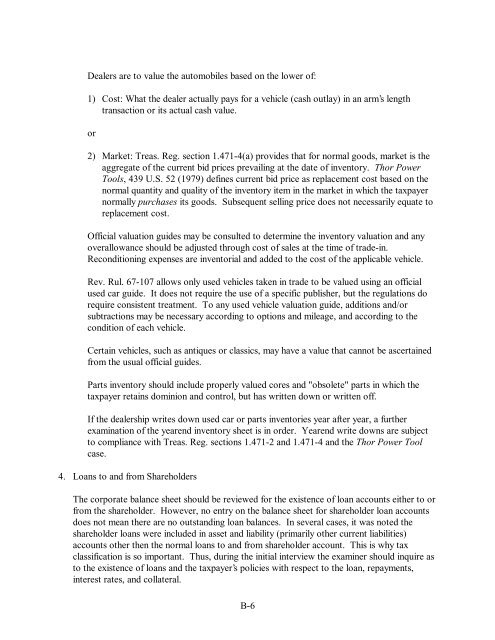Auto Dealerships - Audit Technique Guide - Uncle Fed's Tax*Board
Auto Dealerships - Audit Technique Guide - Uncle Fed's Tax*Board
Auto Dealerships - Audit Technique Guide - Uncle Fed's Tax*Board
Create successful ePaper yourself
Turn your PDF publications into a flip-book with our unique Google optimized e-Paper software.
Dealers are to value the automobiles based on the lower of:<br />
1) Cost: What the dealer actually pays for a vehicle (cash outlay) in an arm’s length<br />
transaction or its actual cash value.<br />
or<br />
2) Market: Treas. Reg. section 1.471-4(a) provides that for normal goods, market is the<br />
aggregate of the current bid prices prevailing at the date of inventory. Thor Power<br />
Tools, 439 U.S. 52 (1979) defines current bid price as replacement cost based on the<br />
normal quantity and quality of the inventory item in the market in which the taxpayer<br />
normally purchases its goods. Subsequent selling price does not necessarily equate to<br />
replacement cost.<br />
Official valuation guides may be consulted to determine the inventory valuation and any<br />
overallowance should be adjusted through cost of sales at the time of trade-in.<br />
Reconditioning expenses are inventorial and added to the cost of the applicable vehicle.<br />
Rev. Rul. 67-107 allows only used vehicles taken in trade to be valued using an official<br />
used car guide. It does not require the use of a specific publisher, but the regulations do<br />
require consistent treatment. To any used vehicle valuation guide, additions and/or<br />
subtractions may be necessary according to options and mileage, and according to the<br />
condition of each vehicle.<br />
Certain vehicles, such as antiques or classics, may have a value that cannot be ascertained<br />
from the usual official guides.<br />
Parts inventory should include properly valued cores and "obsolete" parts in which the<br />
taxpayer retains dominion and control, but has written down or written off.<br />
If the dealership writes down used car or parts inventories year after year, a further<br />
examination of the yearend inventory sheet is in order. Yearend write downs are subject<br />
to compliance with Treas. Reg. sections 1.471-2 and 1.471-4 and the Thor Power Tool<br />
case.<br />
4. Loans to and from Shareholders<br />
The corporate balance sheet should be reviewed for the existence of loan accounts either to or<br />
from the shareholder. However, no entry on the balance sheet for shareholder loan accounts<br />
does not mean there are no outstanding loan balances. In several cases, it was noted the<br />
shareholder loans were included in asset and liability (primarily other current liabilities)<br />
accounts other then the normal loans to and from shareholder account. This is why tax<br />
classification is so important. Thus, during the initial interview the examiner should inquire as<br />
to the existence of loans and the taxpayer’s policies with respect to the loan, repayments,<br />
interest rates, and collateral.<br />
B-6
















